What could an Artificially Intelligent (AI) Blockchain do?
Are Blockchian and Artificial Intelligence (AI) related? No they are not. At least not yet, but together they could do things that we have never even dream of.
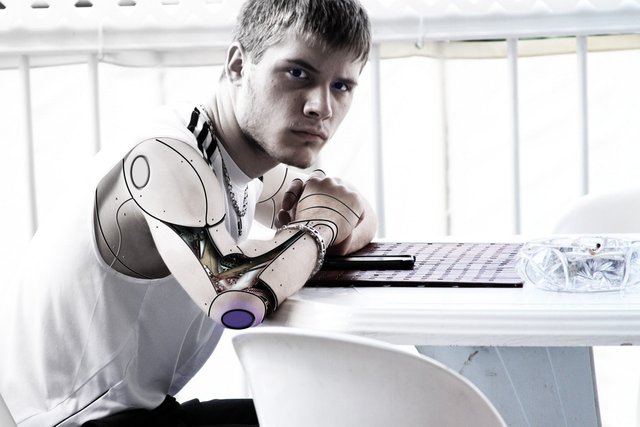
Visual illustration of a part humanoid, part human robot that could be made with the combination of Artificial Intelligence (AI) and Blockchain Technology.[caption]
Blockchain and Artificial Intelligence has been the two most popular and ground breaking technology innovations in the last few years. While the two revolutionary ideas have been lurking in the background of the digital space for more that 40 years, the last 10 years has brought them in leading positions for multimillion dollar mainstream investors and new-age software developers alike. Before we take a deeper dive into what these two mega-ideas can do together, we will take a closer look at what they are already doing individually, starting with a AI.
WHAT IS ARTIFICIAL INTELLIGENCE
AI can be defined as the term applied when a machine mimics "cognitive" functions that humans associate with other human minds, such as "learning" and "problem solving." In other-words, AI is a machine that has the ability to think wholesomely or partially on a human level. AI has been around since the 1950s, lost funding along the way and eventually reemerged in the late 1990s with a new approach, more advanced underlining technology and renewed funding. Trying to emulate the human brain has been nothing but easy for AI research scientists and the field have been plagued with problems in the areas of reasoning, knowledge representation, planning, learning, natural language processing, perception and the ability of AI to move and manipulate objects like human beings seamlessly do. Over the years, the research field has been also subdivided into different groups, with the more populate areas of study being Robotics, Machine Learning and Deep Learning.
Robotics
Robotics is an engineering field that studies the design and application of robots and the use of computer for their manipulation and processing. This field requires the application of computer integrated manufacturing, mechanical engineering, electrical engineering, biological mechanics and software engineering. Automation and Robotics Engineering, a subdivision of Robotics, is the use of control systems and information technologies to reduce the need for human work in the production of goods and services. The "information technology" in this case, has evolved into AI.
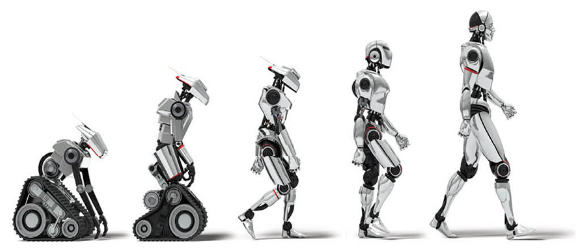
A visual illustration showing the advancements in Robotics with humanoid robots algorithm. Source: Robothub.[caption]
AI and Robotics has grown so closely related now that it's difficult to separate the two. Much like a human beings capability is predominantly driven by its level of intelligence, the capability of robots are predominantly driven by its AI, which is why the field of robotics is seen today by many as a subdivision of AI. BBC News has recently reported that "up to 800 million global workers will lose their jobs by 2030 and be replaced by robotic automation."
Machine Learning
Machine Learning is a method where the computer uses statistical techniques to analyze and learn from a set of data, without being explicitly programmed. The 'learning' here refers to the ability of the computer to assess data and progressively improve overtime. The mount of data that we capture and store on a daily basis is growing exponentially and it doesn't look like it's going to slowdown anytime soon. According to one of Google Cloud Platform's YouTuber:
"Machine Learning brings the promise of deriving meaning from all that data."A simple example of a machine learning model could be an image recognition algorithm where you input an image and the algorithm returns one of two possible outputs, "yes" it is a car or "no" it's not a car. The algorithm can then be given another feature where it could also return the car "model", "year" or "brand". Various classification features can be added to make the machine learning model smarter and smarter.

A visual illustration of machine learning showing how inputs are converted to simple output result after training the AI algorithm. Source: Xenonstack.[caption]
A lot of the digital platforms that we interact with today are actually using machine learning. Here are some of the our regular daily interactions that are powered by machine learning:
- Facebook - photo tagging
- YouTube - next video recommendations
- Google - google search, google maps, gmail
- Siri - voice recognition
- Paypal - detect and combat fraud
- Netflix - next movie, tv series, documentary recommendations
- Uber - arrival times, pick up locations, uberEATS' delivery estimations
- Lyst - matches customer searches with relevant recommendations
- Spotify - list related tracks
Deep Learning
Deep Learning is very similar to Machine Learning; in fact, Deep Learning is a subset of Machine Learning. The difference between the two is that while in Machine Learning the features of the input are manually selected by the user of the algorithm, in Deep Learning the input is just submitted and a more complex neural network observes all the necessary features, classify the input and give a simple output.

A visual illustration of Deep Learning Neutral Network showing how inputs are converted to simple output result after training the AI algorithm. Source: Xenonstack.[caption]
Because of the high similarity between Machine Learning and Deep Learning they usually have the same use cases; however, Deep Learning will always require less work for the input information and, on almost every occasion, has generated better results.
The leader in the Deep Learning space is Google. The more data you have to feed into your Deep Learning model, is the better results you will get; and who has more data than Google? Google has been making huge strides in the space, like creating the most accurate and sophisticated voice recognition software thus far, using the data that they have and they have also made there AI available for public use. Google's Cloud AI also provides modern machine learning as a service, with pre-trained models, as well as a service to generate your own tailored models.
WHAT IS THE BLOCKCHAIN?
A blockchain, originally block chain, is a continuously growing list of records, called blocks, which are linked and secured using cryptography. Each block typically contains a cryptographic hash of the previous block, a timestamp and transaction data. By design, a blockchain is inherently resistant to modification of the data. The idea was engineered by an unknown person or group of people that goes by the pseudonym, Nakamoto Satoshi. The first use case for the blockchain was to securely transfer value over the internet via Bitcoin.
How does Bitcoin work?
Nakamoto Satoshi wanted people to be able to securely transfer money over the internet without the use of a third party like a Bank or a company like PayPal.
"In 2008, a programmer known as Satoshi Nakamoto—a name believed to be an alias—posted a paper outlining Bitcoin’s design to a cryptography e-mail list. Then, in early 2009, he, she, or they released software that can be used to exchange bitcoins using the scheme. That software is now maintained by a volunteer open-source community coordinated by four core developers." source: MIT technology reviewBitcoin can be sent from user to user on a pee-to-peer Bitcoin network directly. The transactions are verified by network nodes using cryptography and recorded on the blockchain. Bitcoins are also earned on the network through a process know as Mining. Mining is essentially record-keeping service down through the the use of computing power. Miner help to validates the Bitcoin network by grouping all recent transaction in the most recent block and broadcasting it to all the nodes of the network. In order to receive and send bitcoin via the network the user must have a Wallet, which is very similar to a bank account. In complete, all four functions of the Bitcoin network are: the full blockchain, network, miners and wallet.
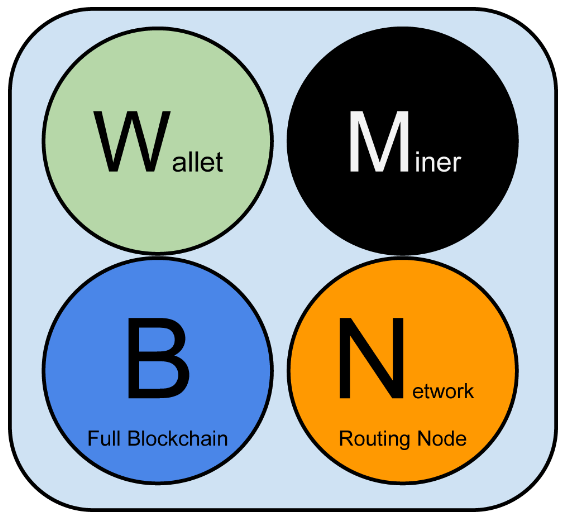 Visual illustration of Bitcoin Network Node with all four functions: wallet, miner, full blockchain database and network routing. Source: Safari[caption]
Visual illustration of Bitcoin Network Node with all four functions: wallet, miner, full blockchain database and network routing. Source: Safari[caption]
What are Cryptocurrencies?
Cryptocurrency is a digital asset designed to to work as a medium of exchange that uses cryptography to secure its transactions, to control the creation of additional units, and to verify the transfer of assets. Bitcoin was the first cryptocurrency, but since bitcoin was released by Nakamoto Satoshi in 2009 there has been hundreds more cryptocurrencies to follow, like Ethereum (ETH), Dash, EOS, Litecoin (LTC), Ripple (XRP), Bitcoin Cash (BCH), Ethereum Classic (ETC) and Z Cash (ZEC). Almost all cryptocurrencies use the blockchain technology as their backbone. Some cryptocurrency projects, like Bitcoin Cash, have modified the Bitcoin blockchain protocol to add more functionalities, while others like Ethereum, EOS and Cardano (ADA) have built their own blockchain from scratch to do much more than the Bitcoin blockchain will ever have to offer.
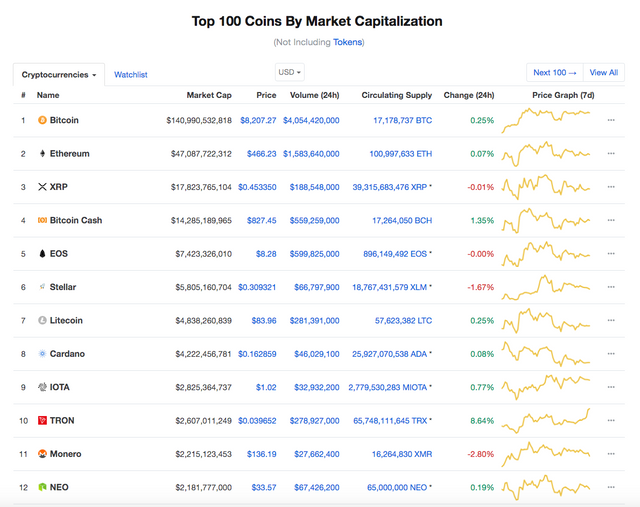 visual illustration of Coinmarketcap showing the top 12 cryptocurrencies by name, market cap, price, volume (24h), circulating supply and change (24h).[caption]
visual illustration of Coinmarketcap showing the top 12 cryptocurrencies by name, market cap, price, volume (24h), circulating supply and change (24h).[caption]
Almost all cryptocurrencies are list on a cryptocurrency exchange, like Coinbase, Poloniex, Bittrex, Bitfinex, Ok Exchange, Binance, and can be traded again the USD or other cryptocurrency. A full list of all the cryptocurrencies and their related exchanges, website, charts and price can be observed in real time Coinmarketcap or Cryptoporridge.
Bitcoin has faced a number of difficulties like the inability to scale, low transaction speed and increasing transaction fees. Newer blockchain models, like Ethereum, EOS and Cardano have manage to solve some or all of these problems, and as such are better positioned to break mainstream and create a general/universal blockchain platform. Bitcoin is now classified as a 1st generation cryptocurrency while cryptocurrencies like Ethereum, EOS and Cardano are considered 2nd or 3rd generation cryptocurrencies because of their superior functionalities in comparison to Bitcoin. All 2nd and 3rd generation cryptocurrencies allow users to interact with Smart Contracts and developers are able to produce their own cryptocurrency on the blockchain in the form of what is refered to as a cryptocurrency Token.
What is a cryptocurrency Token?
In the cryptocurrency space, all digital assets created after Bitcoin is regarded as a cryptocurrency, even though not all of the fulfill the criteria to be a currency. Tokens are a representation of a particular asset or utility, that usually resides on top of another blockchain.
What is a cryptocurrency Coin?
A cryptocurrency coin is any asset or utility cryptocurrency that does not reside on another blockchain.
What is a Altcoin?
An Altcoin is any alternative cryptocurrency to Bitcoin. So cryptocurrencies such as Ethereum, Dash, EOS, Cardano, Ripple, Ethereum Classic and Litecoin are all regarded as Altcoins. Most Altcoins are forks of Bitcoin or other cryptocurrencies.
What is a cryptocurrency Hard Fork vs Soft Fork?
A hard Fork (or sometimes hardfork) is a radical change to the protocol that makes previously valid blocks/transactions invalid (or vice-versa). When their is a hard fork all nodes or users are required to upgrade to the latest version. While a soft fork, as it relates to blockchain, is a minor change to the blockchain protocol where the users of the blockchain are not required to upgrade to a new version as all blocks will still be available to the users.
What is cryptocurrency decentralization vs centralization?
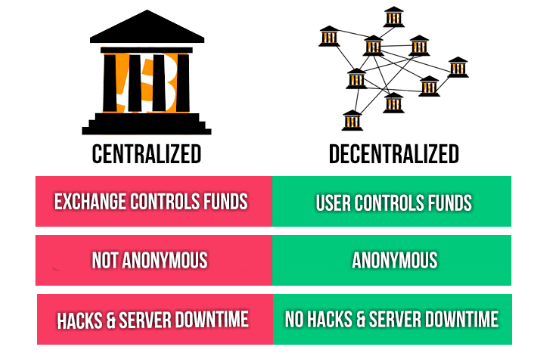
Visual illustration of a decentralized system vs a centralized system. source: Cryptocompare.[caption]
Cryptocurrency is a digital, virtual or alternative currency that works through a distributed ledger (Blockchain). After the latest block of transactions is produced on the blockchain through verification by Miners, a copy of the entire ledger or record is then distributed to all nodes on the network. As each new copy of the ledger contains also previous transactions, it is almost impossible for any one node holder to change any information on the blockchain. This gives every node holder equal responsibility and power over the blockchain activities and thus making the network decentralized.
A centralized entity is more like a modern Bank or Government where all the information is kept in one location and only a central party has access, control and power over how that information is distributed and used. Almost all cryptocurrencies are decentralized because of the nature of the blockchain and can be traded on decentralized exchange trading platforms like Binance, Bitsqaure (Bisq), EtherDelta and IDEX.
COMBINING AI AND BLOCKCHAIN
Ok, now that we are all updated on what AI and Blockchain is, lets combine the two technologies and see what happens.
What are the differences between AI and Blockchain?
- The main difference between the two is that AI is for extracting answers and forecast from huge amount of data, while the Blockchain is used to verify various types of transactions; so in other words, AI is probabilistic while Blockchain is deterministic.
- AI is always changing, while Blockchain is permanent.
- AI is algorithm to guess or predict reality, while Blockchain keeps a record of reality.
- AI is centralized, while Blockchain is decentralized.
- AI has known owners and users, while Blockchain can be anonymous.
- Both AI and Blockchain are digital algorithms.
- AI and Blockchain are both heavily funded.
- AI and Blockchain both attract the best and brightest developers.
The combination of AI and Blockchain can produce untouchable intelligence. Much in the way that a human can intelligently make up his or her own mind and choose its own direction, an AI is able to do the same; however, in a centralize system you have the government and other authoritative entities that have the powder to either allow a human or AI to proceed in it's chosen path. An AI that lives in a fully decentralized algorithm such as the blockchain would be very difficult if not impossible to control. Picture an untouchable general AI that is able to learn and grows exponentially through a decentralized internet, that is possible with the combination of AI and Blockchain - be it positive or negative.
There are already a few existing projects that are built around the combination of AI and Blockchain, and here are a few of them as well as theoretical ideas:
"With Open Mined, an AI model can be governed by multiple owners and trained securely on an unseen, distributed data set."
 Visual illustration of the OpenMined website homepage.[caption]
Visual illustration of the OpenMined website homepage.[caption]
The OpenMined community is on a mission to create an accessible ecosystem of tools for private, secure, multi-owner governed AI. They will do this by extending popular libraries like TensorFlow and PyTorch with advanced techniques in cryptography and private machine learning.
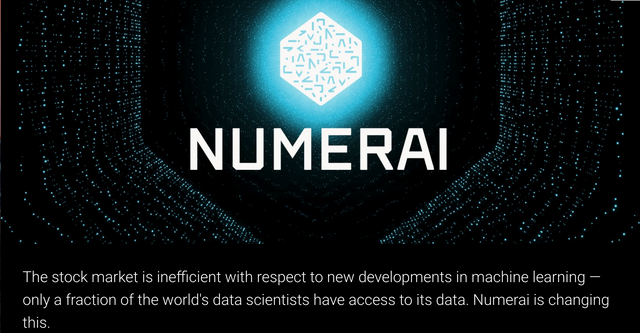
Visual illustration of NumerAI's website homepage.[caption]
NumerAI aims to be a decentralized AI hedge fund. They will provide the data of the stock market to data scientist across the globe, the data scientist will the use their AI to make predictions and submit their prediction back to NumerAI. The data scientist with the most accurate prediction will be compensated using Tokens. This will all be done on the blockchain through smart contracts so there is no need for any of the parties to trust anyone as the decentralized world is a trustless one. The AI models may also be submitted by each data scientist which will be used to make a metamodel.
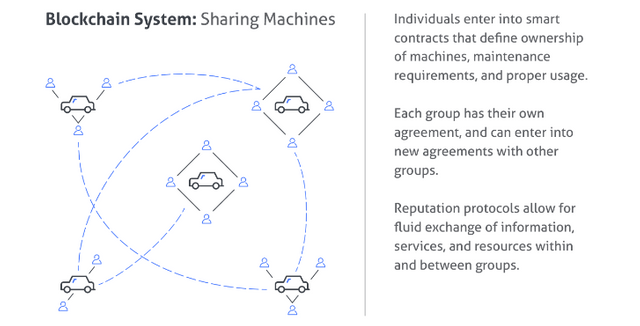
Visual Illustration of a self driving car network on the blockchain. source: consensys.[/caption]
Smart, AI driven car are already here and soon they will be everywhere. But how has is a AI that is centrally controlled? Having your AI driven car controlled at a central location will give hackers access to the entire network which makes the system very vulnerable. Having the system on the blockchain would solve these problems as the system would be decentralized and as such almost impossible to any one to hack. The cars could also communicate directly with each other without any third party involved and you will be at peace knowing that you're commuting safe.
There are so many other ideas that will emerge from the merger of AI and Blockchain, but the most amazing that I can thing of at this point in time is a true free and untouchable AI which has limitless capabilities.
Can you think of any other big ideas that could emerge from the union of IA and Blockchain? Do you think it will be positive or negative for us? you can leave your comments below.
Cryptoporridge.com.
You have a minor grammatical mistake in the following sentence:
It should be their own instead of there own.Thanks for the heads up.